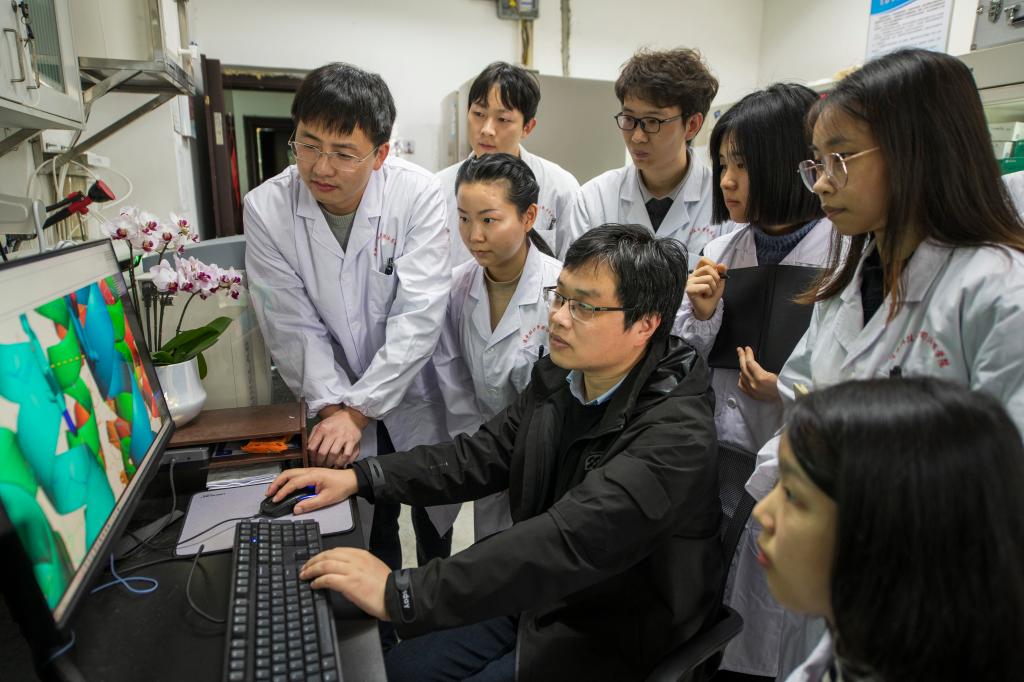On March 22nd, internationally renowned academic journal Nature published the research article entitled "Structural and mechanistic insights into fungal β-1,3-glucan synthase FKS1" by Hongjun Yu and Min Zhang's team from the School of Basic Medicine of Huazhong University of Science and Technology, in collaboration with Xiaotian Liu from the Southern University of Science and Technology. This study solves the mystery of fungal cell wall β-1,3-glucan synthesis, an important target of antifungal drugs. It is of great scientific significance for dealing with the clinical problem of invasive fungal infections.

Invasive fungal infections are common in high-risk populations such as those with immune deficiencies, organ transplant recipients, and severe COVID-19 patients, causing over 1.5 million deaths every year. However, the treatment of this serious disease is facing severe challenges, including limited types of drugs, side effects of drugs, and the emergence of drug-resistance. Therefore, it is of urgent demand to develop new antifungal drugs. β-1,3-glucan is the core polysaccharide component unique to the fungal cell wall, and its synthesis pathway is a key target for developing antifungal drugs. Successful targeted drugs include the widely used echinocandin class of first-line drugs and the recently approved new drugs ibrexafungerp and rezafungin. However, for a long time, there has been a lack of understanding of the mechanism of synthesis of β-1,3-glucan in the fungal cell wall and related drug resistance, seriously hindering the development of new drugs in this field.
To address the above problems, the research team combined multiple methods and firmly demonstrated that FKS1 is the specific synthase for fungal cell wall β-1,3-glucan. Based on this, a practical radiolabel-free assay system for FKS1 was developed, which has useful application potential in establishing an efficient drug screening system. Furthermore, the researchers solved the cryoEM structure of FKS1 and identified two key functional regions of FKS1, including the catalytic site of the enzyme at the membrane-cytoplasm interface and a semi-closed glucan translocation path spanning the membrane bilayer, clarifying the molecular basis of glucan synthesis by FKS1. This mechanism is highly conserved in prominent fungal pathogens and has important significance for the development of broad-spectrum antifungal drugs.
To explore the mechanism of drug resistance, the researchers revealed the spatial distribution and characteristics of resistance-related hotspot regions and confirmed that mutations in these sites significantly reduce drug sensitivity of FKS1. They ultimately solved the structure of FKS1-S643P, one of the most frequently observed echinocandin-resistant mutations in the clinic. The structure revealed altered lipid arrangements, suggesting a unique molecular mechanism of drug resistance.
In conclusion, the above study has advanced the mechanistic understanding β-1,3-glucan synthesis in fungal cell walls. It reveals the molecular basis of resistance to widely prescribed antifungal drug echinocandin. These insights and assay methods in this study are valuable for promoting the development of new antifungal drugs and helpful for solving the clinical problem of invasive fungal infections.
Profs. Hongjun Yu, Min Zhang and Xiaotian Liu are the co-corresponding authors of this paper. Xinlin Hu and Ping Yang from the School of Basic Medicine of Huazhong University of Science and Technology are co-first authors. This research has been supported by the National Natural Science Foundation of China, the Fundamental Research Funds for the Central Universities, Program of HUST Academic Frontier Youth Team and ShenZhen Talent Program.

This paper is another research breakthrough in the field of antifungal drug targets by the team of Profs. Yu Hongjun and Zhang Min from the School of Basic Medicine, following their previous paper “Structures and mechanism of chitin synthase and its inhibition by antifungal drug Nikkomycin Z” (Cell Discovery. 2022;8(1):129.). The team has engaged in the mechanistic study of disease-related proteins, especially the mechanism and intervention of eukaryotic glycosylation and their therapeutic applications. Their research results have been published in several internationally renowned journals, such as Nature, Cell, Nature Chemical Biology, PNAS, and Nature Communications.